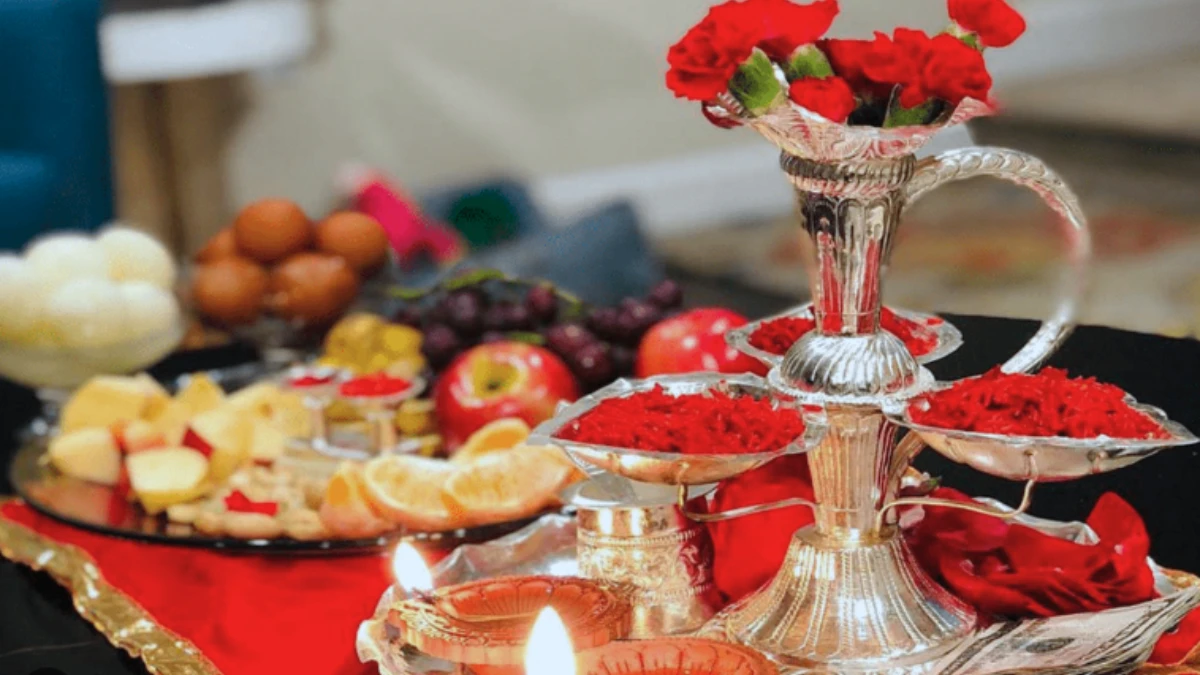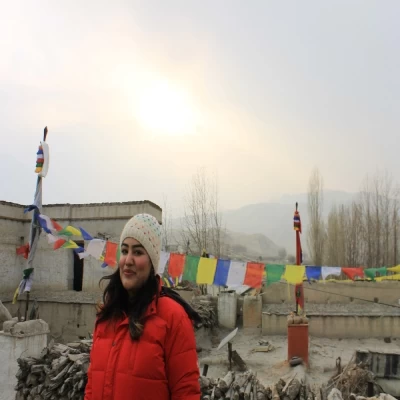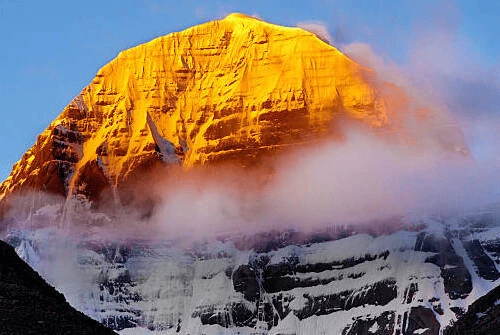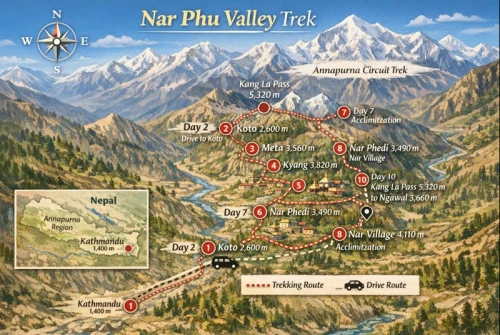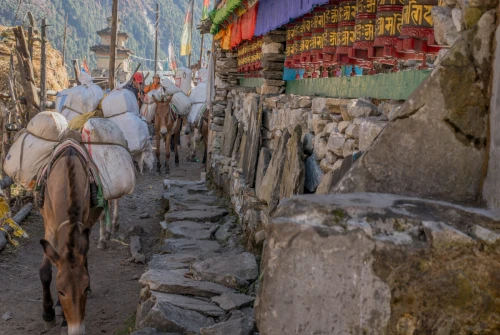Introduction
Nepal is a dream destination for trekkers, but if you time your journey during Dashain,the country’s most cherished festival, your experience becomes much more than just walking trails and admiring mountains. Dashain is not just a holiday; it’s a nationwide celebration that unites families, communities, and entire regions under one spirit of joy and blessing. For tourists, trekking during this festival means that every step on the trail is enriched with cultural color, festive sounds, and opportunities to witness traditions that date back centuries.
Dashain typically falls in October (sometimes late September or early November), coinciding perfectly with Nepal’s autumn trekking season, the time of year when skies are clearest, mountain views are sharpest, and trails are most inviting. While you may know Nepal for Everest, Annapurna, or Langtang, trekking during Dashain adds another dimension; you get the Himalayas and the heartbeat of Nepali life.
In this guide, we’ll dive into everything you need to know: what Dashain is, how it’s celebrated, why trekking during this festival is so special, the challenges you should prepare for, and the best treks to choose. Whether you want to explore Kathmandu and Pokhara during the celebrations or hike remote trails filled with village festivities, this article is your complete guide to trekking in Nepal during Dashain.
What is Dashain?
Dashain, also known as Bada Dashain, is the biggest Hindu festival in Nepal, celebrated with unmatched enthusiasm and devotion. It symbolizes the victory of good over evil, primarily honoring Goddess Durga, who defeated the demon Mahishasura. For Nepali people, Dashain is more than just a religious event—it’s a time for renewal, family gatherings, and blessings for prosperity.
The festival usually spans 15 days, following the lunar calendar, making it one of the longest and most significant celebrations in South Asia. Each day has its rituals and significance, with the main highlights being:
Ghatasthapana (Day 1): The start of Dashain, where jamara (barley seeds) are planted in a sacred pot to symbolize prosperity.
Maha Ashtami (Day 8): Known for sacrifices and special prayers to Goddess Durga.
Maha Navami (Day 9): A day of worship, feasts, and temple rituals.
Vijaya Dashami (Day 10): The most important day, when elders place tika (a red vermilion mark mixed with rice and yogurt) and jamara on the foreheads of younger family members, giving blessings for good fortune.
For tourists, witnessing these traditions is eye-opening. Imagine being welcomed into a Nepali household, receiving tika from elders, or seeing vibrant markets filled with families buying new clothes, kites flying high in the sky, and swings made of bamboo (called ping) swaying in the village air.
Dashain is not confined to temples or homes; it spills into the streets, hills, and valleys, making it one of the most immersive cultural experiences you can witness while trekking in Nepal.
How Dashain is Celebrated in Nepal
The beauty of Dashain lies in its diversity of celebrations across Nepal. In urban areas like Kathmandu and Pokhara, the festival is marked by decorated temples, buzzing marketplaces, and families traveling back to their ancestral homes. In rural villages, where many trekking trails pass through, the customs are even more colorful and intimate.
In Villages:
Families build traditional swings from bamboo and ropes, where children (and sometimes adults!) spend hours. You’ll hear the laughter of kids, the melodies of folk songs, and see villagers preparing feasts. Rituals include animal sacrifices, communal gatherings, and temple worship. Trekking through villages during this time means you’ll likely come across locals inviting you to join celebrations.In Cities:
Kathmandu, with its ancient temples and Durbar Squares, becomes a hub of activity. Families shop for new clothes, while kites fill the skies—symbolizing freedom and the joy of victory. Streets glow with decorations, and temples overflow with devotees offering prayers. Pokhara, with its laid-back vibe, sees celebrations along Lakeside, where the lake’s reflection adds a magical touch to the festivities.In Homes:
Dashain is a family festival. Homes are cleaned and repainted, meals are prepared with delicacies like goat curry, sel roti (a traditional Nepali bread), and sweets. Elders bless younger family members with tika and jamara, a ritual tourists may be lucky enough to experience if invited by their guide, porter, or local families along trekking routes.
For trekkers, this means that the trail itself becomes a living cultural showcase. Every village you pass might offer a new sight: children swinging on bamboo structures, families in colorful attire, or processions heading toward temples. It’s as much about walking as it is about immersing in Nepali life.
Why Trek During Dashain?
Trekking during Dashain is about more than landscapes—it’s about connecting with Nepal at its most joyful time of year. Here are the main reasons why this period is special for tourists:
Cultural Immersion
Trekking during Dashain allows you to step directly into Nepali traditions. Unlike ordinary treks, where your interaction may be limited to guesthouses, Dashain opens doors. Villagers may invite you into homes, guides and porters often celebrate along the way, and you’ll get front-row seats to rituals that have been passed down for centuries.Perfect Weather and Scenery
Dashain aligns with the autumn trekking season—arguably the best time for hiking in Nepal. The monsoon rains have just cleared the dust, leaving trails lush and clean. Skies are crisp and blue, offering clear views of Himalayan giants like Annapurna, Machhapuchhre, and Everest. Temperatures are moderate, making long walks comfortable.Festive Atmosphere Everywhere
Imagine trekking into a small mountain village and seeing it decorated with flowers, swings, and colorful rituals. Instead of just stopping for tea, you might join in singing, dancing, or even receive a tika from locals. The joyous energy is contagious, giving your trek a deeper emotional layer.
In short, trekking during Dashain blends adventure with culture, creating a journey that is both physical and spiritual. You’ll come home with not just photos of mountains but also stories of laughter, blessings, and traditions that you shared along the way.
Challenges and Considerations for Tourists
Of course, trekking during a major festival isn’t without its challenges. While the rewards are immense, it’s important to prepare for the following:
Crowds and High Demand
Since Dashain coincides with peak trekking season, trails like Everest Base Camp and Annapurna Circuit get crowded. Villages, buses, and teahouses can be full, so securing accommodation requires booking.Costs and Availability
Prices for flights, transport, and even meals can rise during Dashain. Some guides and porters may request higher wages or extra tips since they’re working away from their families.Travel Logistics
During key Dashain days, many Nepalis travel to their hometowns. This means buses, flights, and taxis are often fully booked. In addition, some services (like banks or small shops) may close temporarily during the main festival days.Balancing Trekking and Festival Days
If you start your trek on Tika day, you may find villages quieter as families stay indoors for blessings. On the other hand, joining in such rituals could be a highlight. Planning your itinerary carefully ensures you don’t miss the best cultural experiences.
By understanding these challenges and preparing ahead, you can avoid frustrations and fully enjoy trekking during this vibrant time.
Best Treks to Experience During Dashain
One of the most common questions visitors ask is: Which treks are best during Dashain? The good news is that the festival coincides with Nepal’s autumn trekking season, widely regarded as the most rewarding time to explore the Himalayas. The skies are at their clearest, the weather is stable, and the mountain views are simply jaw-dropping. But during Dashain, trekking becomes even more special. Villages along the trails are alive with rituals, decorations, bamboo swings, and family gatherings, offering trekkers a rare opportunity to blend cultural celebrations with natural exploration. Below are the treks that offer the best mix of scenery, adventure, and Dashain festivities.
1. Ghorepani Poon Hill Trek (4–5 Days)
The Ghorepani Poon Hill Trek is one of the most popular short treks in Nepal and a perfect choice if you want to enjoy both culture and scenery in just a few days. The highlight of the trek is the Poon Hill sunrise, where the first golden rays of the sun light up the Annapurna and Dhaulagiri ranges, creating one of the most iconic Himalayan panoramas. Along the way, you’ll pass through traditional Gurung and Magar villages, lush rhododendron forests, and terraced farmlands that paint a quintessential Nepali landscape.
During Dashain, this trek takes on a whole new charm. Villages like Ghorepani and Ghandruk buzz with energy—families return from cities to celebrate together, homes are decorated, and large bamboo swings (locally called linge ping) are built for children. Trekkers often find themselves invited into local homes for tika blessings or to share festival meals such as sel roti, goat curry, and yogurt. What makes this trek so special during Dashain is the sense of community and celebration—you’re not just hiking through villages, you’re walking into a living festival. The short duration of the trek also makes it perfect for travelers who want to witness Dashain festivities without committing to long, strenuous routes.
2. Mardi Himal Trek (7–9 Days)
The Mardi Himal Trek is a hidden gem that remains quieter compared to Annapurna Base Camp or Poon Hill. It’s an ideal trek for those seeking solitude while still enjoying spectacular Himalayan views. The trail takes you through lush forests, high ridges, and alpine meadows, with breathtaking close-up views of Machhapuchhre (Fishtail Mountain) and the Annapurna range. Unlike busier trails, Mardi Himal feels more peaceful, giving trekkers a stronger connection to nature.
When you trek here during Dashain, the experience becomes both tranquil and culturally vibrant. The villages along the route are smaller and more intimate, which means you’ll witness authentic rural celebrations. Families erect swings for their children, elders prepare tika and jamara blessings, and the aroma of festival cooking drifts through the air. Since Mardi Himal is less commercialized, trekkers are more likely to be welcomed into private homes for local festivals, offering an up-close look at traditional customs. The mix of serene landscapes and heartfelt hospitality makes Mardi Himal during Dashain truly special. You’re not just trekking—you’re building bonds with local families during their most important holiday.
3. Langtang Valley Trek (6–8 Days)
TheLangtang Valley Trek is a perfect choice for those who want cultural richness paired with Himalayan landscapes. Located north of Kathmandu, this trek is accessible yet rewarding, offering views of snow-capped peaks, vast yak pastures, and glaciers. The trail passes through Langtang National Park, home to diverse flora and fauna, and ends at Kyanjin Gompa, a serene monastery with sweeping mountain views.
What makes trekking in Langtang special during Dashain is the way the valley celebrates the festival. Unlike other regions, Langtang combines both Hindu and Buddhist influences, creating a unique cultural blend. Villagers prepare tika and jamara like elsewhere in Nepal, but they also perform Buddhist rituals and prayers at monasteries. For trekkers, this means you can witness the harmony of two traditions coexisting in a single valley. During Dashain, homes are filled with music, swings are set up in villages, and travelers are warmly invited to join in. The Langtang Valley is still rebuilding after the 2015 earthquake, so celebrating Dashain here with locals feels especially meaningful—it’s a chance to support communities while being part of their joy.
4. Gosaikunda Lake Trek (5–7 Days)
The Gosaikunda Lake Trek is one of Nepal’s most spiritual journeys, taking trekkers to sacred alpine lakes located at over 4,000 meters. These turquoise lakes are revered by both Hindus and Buddhists, with legends linking them to Lord Shiva. The trek involves steep climbs and high passes but rewards you with surreal landscapes of lakes shimmering against the backdrop of snow-covered peaks.
During Dashain, this trek becomes even more powerful. Many locals use their holiday to make pilgrimages to Gosaikunda, so the trail is filled with both trekkers and devotees. This creates a lively yet spiritual atmosphere—you’ll see families carrying offerings, elders performing pujas, and communities coming together in celebration. Joining this trek during Dashain means you’re not just exploring nature but also walking alongside pilgrims who see this journey as sacred. The cultural significance, combined with the dramatic beauty of the lakes, makes trekking to Gosaikunda during Dashain a truly soulful experience.
5. Everest Base Camp Trek (12–14+ Days)
The Everest Base Camp (EBC) Trek is the dream trek for adventurers worldwide. Over two weeks, you’ll journey through Sherpa villages, cross suspension bridges, visit Tengboche Monastery, and stand at the foot of the world’s tallest mountain. The trek offers dramatic landscapes, from lush forests at lower altitudes to the stark beauty of the Khumbu Glacier at higher elevations. The sense of achievement upon reaching base camp is unmatched.
During Dashain, the Everest region carries its own festive charm. Though remote, Sherpa communities still celebrate by building swings, offering tika blessings, and preparing festival meals. Many guides and porters also celebrate Dashain and often invite trekkers to join them. Imagine receiving tika at Tengboche Monastery or sharing a meal with Sherpa families on your way to Everest Base Camp—it’s a cultural layer that adds depth to the trek’s already epic adventure. Trekking to EBC during Dashain isn’t just about conquering mountains; it’s about sharing joy and blessings with the people who call these mountains home.
6. Annapurna Base Camp Trek (7–12 Days)
The Annapurna Base Camp (ABC) Trekis one of the most popular and rewarding treks in Nepal. It offers a diverse journey through terraced farmlands, dense rhododendron forests, and high alpine landscapes, leading to the spectacular amphitheater of Annapurna I, Machhapuchhre, and Hiunchuli. Unlike Everest, ABC is less extreme in altitude yet equally dramatic in scenery, making it ideal for trekkers seeking both challenge and accessibility.
During Dashain, this trek is transformed into a cultural festival. Villages like Chhomrong and Jhinu become alive with music, laughter, and rituals as families return home to celebrate. Bamboo swings are built, tika ceremonies are performed, and traditional feasts bring communities together. For trekkers, this means more than just walking toward base camp—you’re immersed in the rhythm of festival life at every stop. Watching the sunrise over Annapurna while hearing the sounds of festival drums from nearby villages creates an unforgettable experience. Trekking ABC during Dashain is special because it combines world-class mountain views with the warmth of Nepal’s biggest celebration, making it one of the most complete cultural and natural adventures you can have.
Experiencing Nepalese Culture While Trekking
Trekking during Dashain is not just about walking trails; it’s about immersing yourself in Nepali culture. Every village you pass has a story to tell, and during this festival, those stories come alive.
- Village Encounters: Imagine trekking through a Gurung or Tamang village and seeing children swinging on bamboo structures, women preparing sel roti, and men setting up community feasts. Unlike regular treks, you’re not just passing through; you’re invited to take part.
- Food & Hospitality: Nepali households prepare special dishes during Dashain. If you’re lucky, you might be offered goat curry, beaten rice, yogurt, or homemade sweets. Eating with locals adds warmth and authenticity to your journey.
- Ritual Participation: Some trekkers receive tika and jamara from locals or guides, a deeply meaningful blessing. Respect and gratitude go a long way if you’re included in such traditions.
This cultural immersion transforms trekking from a physical challenge into a spiritual and emotional journey, leaving you with stories you’ll cherish forever.
Dashain Atmosphere in Kathmandu and Pokhara
If you spend time in Kathmandu or Pokhara before or after your trek, you’ll get another layer of Dashain experience.
Kathmandu:
The capital bursts with energy. Temples like Pashupatinath and Durbar Squares become crowded with devotees. The skies above Basantapur and Patan fill with colorful kites, symbolizing freedom and joy. Markets overflow with families buying new clothes and festival essentials. You’ll see traditional swings in open spaces, street vendors selling sweets, and processions filled with music.Pokhara:
More relaxed but equally festive. Along the lakeside, families gather to celebrate, and the reflection of kites and lights on Phewa Lake adds magic. Villages around Pokhara—such as Dhampus or Ghandruk—become hubs of celebration where you can experience Dashain traditions in a more rural setting.
Tourists often find that spending a day or two in either city during Dashain gives them a broader cultural perspective before heading to the mountains.
Practical Tips for Trekking During Dashain
To make your trek smooth and enjoyable, here are practical tips tailored for the Dashain season:
- Plan Your Dates: Check the festival calendar, as Dashain dates shift each year. If you want to witness Tika day in a village, plan your trek accordingly.
- Book Early: Flights, buses, and teahouses fill quickly. Book guides, porters, and accommodation ahead of time.
- Pack for Autumn Weather: Carry layers for chilly nights, waterproofs for unexpected showers, and sturdy boots.
- Carry Enough Cash: ATMs may not be available on treks, and banks often close on festival days.
- Be Flexible: Some teahouses may close if owners leave for the festival. Having backup plans and extra snacks helps.
- Respect Local Customs: Dress modestly, especially near temples. Always ask before joining rituals or taking photos.
- Travel Insurance: Essential for trekking—make sure it covers altitude, accidents, and medical evacuation.
By following these tips, you’ll avoid common problems and make the most of the festival-spirit trekking adventure.
Respecting Local Traditions
As a tourist, you are not just an observer; you’re often welcomed as a participant. Respect is key.
At Temples: Remove shoes, avoid stepping on thresholds, and dress modestly.
Accepting Tika: If someone offers you tika and jamara, bow slightly, accept with your right hand, and express thanks with a smile.
Do’s and Don’ts:
Do greet people with “Namaste.”
Do try the local foods offered during the festival.
Don’t refuse Tika rudely; if you’re uncomfortable, politely explain.
Don’t intrude on private family ceremonies without being invited.
Showing cultural sensitivity ensures you’re remembered as a respectful guest, not just a passing tourist.
Weather During Dashain Season
One of the best reasons to trek during Dashain is the ideal autumn weather. After the monsoon season ends, Nepal’s skies clear, and the air feels fresh and crisp. For trekkers, this translates into perfect visibility, pleasant daytime temperatures, and safer trails.
- Temperature Ranges: In lower-altitude areas like Kathmandu, Pokhara, and foothill villages, daytime temperatures hover between 15°C and 25°C (59°F to 77°F). In higher altitudes above 3,000 meters, days are cooler (5°C to 15°C), while nights can drop below freezing.
- Clear Skies: October is known for crystal-clear skies, meaning you’ll enjoy unobstructed views of Himalayan peaks such as Annapurna, Dhaulagiri, Langtang, and Everest.
- Trail Conditions: Monsoon rains leave behind lush greenery and blooming landscapes, making trails scenic and refreshing. By Dashain, landslides and heavy rains have mostly subsided, so paths are more stable.
- Occasional Showers: While rare, late-monsoon showers can still appear early in the season, so lightweight rain gear is smart to pack.
In short, the Dashain season offers the perfect mix of scenery and safety, making it one of the most sought-after trekking periods in Nepal.
Food and Accommodation on Treks During Dashain
Food and lodging are integral parts of any trek, and during Dashain, they come with a unique cultural twist.
- Teahouses and Lodges: Most trekking regions like Annapurna, Everest, and Langtang have well-established teahouse networks. These lodges remain open during Dashain, though in very remote areas some families might temporarily leave to celebrate in their villages. Booking ahead avoids surprises.
- Festival Foods: One of the joys of trekking during Dashain is tasting seasonal dishes. Expect hearty meals like goat curry, fried fish, sel roti (a sweet, ring-shaped bread), yogurt, and traditional sweets. Many teahouses prepare festive variations of their usual meals, especially on big festival days.
- Shared Experiences: Teahouses often become cultural hubs where locals, trekkers, and staff celebrate together. You might share a communal meal, join in singing or dancing, or even receive a tika from the lodge owners.
Accommodation standards vary from simple wooden lodges to more comfortable guesthouses with hot showers and Wi-Fi. During Dashain, it’s wise to book in advance since domestic tourists also travel to trekking areas for holidays.
Health and Safety Considerations
Trekking during Dashain is exciting, but safety must remain a top priority.
Altitude Sickness: Many popular treks like Everest Base Camp or Annapurna Circuit involve high altitudes. Acclimatization days, hydration, and a slow pace are essential to prevent altitude sickness.
Medical Services: While larger villages have health posts, medical facilities are limited. Carry a personal first-aid kit with essentials like pain relievers, rehydration salts, and altitude sickness medication (if prescribed).
Festival Impact: Some medical staff may be on holiday during Dashain, so don’t rely on quick access to clinics. Prepare in advance.
Travel Insurance: Ensure your insurance covers trekking at high altitudes and emergency helicopter evacuation.
General Safety Tips:
Drink purified or boiled water.
Avoid uncooked food in remote areas.
Stick to marked trails—some locals may be distracted by festivities.
With preparation and awareness, trekking during Dashain is both safe and rewarding.
Benefits of Trekking in Nepal During Dashain
Trekking in Nepal is always memorable, but Dashain makes it extraordinary. Here’s why:
- Cultural Enrichment: You don’t just walk through villages, you experience them. From tika ceremonies to bamboo swings, every stop feels like a festival.
- Scenic Brilliance: Dashain coincides with Nepal’s most beautiful trekking season. Mountains appear sharper, skies are clearer, and landscapes are vibrant.
- Festive Atmosphere: Villages are full of music, laughter, and tradition. You feel the joy everywhere, making your trek uplifting and heartwarming.
- Photography Opportunities: Imagine photographing Mount Annapurna at sunrise with colorful kites in the sky or children playing on bamboo swings against mountain backdrops.
- Authentic Connections: Locals are in high spirits and more welcoming than ever. Many trekkers form lasting friendships during this season.
Dashain transforms trekking into a fusion of adventure and culture, making it one of the best times to explore Nepal.
Conclusion
Trekking in Nepal during Dashain is more than just an outdoor adventure; it’s a journey into the soul of Nepalese culture. The combination of clear autumn skies, Himalayan landscapes, and a nation celebrating its most important festival creates an experience that is both magical and meaningful. Whether you’re hiking to Everest Base Camp, exploring the serene Gosaikunda lakes, or enjoying the short yet beautiful Ghorepani Poon Hill trek, Dashain adds festive warmth and human connection to every step. With careful planning, respect for traditions, and an open heart, trekking during Dashain becomes a once-in-a-lifetime adventure.
